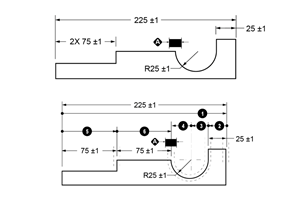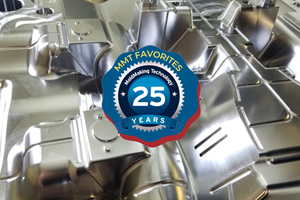Product Data Integration: The Big Picture
How does a company establish effective data integration? Here are six trouble spots, where you may be able to vastly improve productivity.
Companies can save from $100,000 to several millions of dollars annually in personnel costs and other direct expenses through more effective integration. How then does any company establish effective data integration? Everyone wants a magic bullet. Sadly, none exists. Why? Because there is no one single cause of data integration problems. Rather, integration involves many complex areas and varies by company or system. Here are six trouble spots, where you may be able to vastly improve productivity.
1. Quality of Native CAD Data
You cannot exchange data effectively if the original data itself is not of high quality. Data may appear correct in the native CAD system, but have characteristics unacceptable to other CAD systems. Models have been encountered where a through-hole was eliminated by putting surfaces over the end. While this appeared correctly in the native CAD system, it did not translate to most other systems. Other common problems include minute cracks, gaps between adjacent surfaces, sliver surfaces and similar characteristics that adversely affect model interoperability.
Since a given model may be exchanged several times, each recipient is faced with resolving the same problems repeatedly. Appropriate tools and processes can identify and eliminate modeling techniques that lead to exchange problems.
2. Quality of Data Exchange
This is the first - and often the only - area considered by most companies. Current CAD capabilities provide robust data exchange, including standards-based methodologies such as IGES (Initial Graphics Exchange Specification) and STEP (Standard for the Exchange of Product Model Data), as well as direct translators. However, simply using standard translators with default options will rarely provide the quality desired.
Many CAD systems make assumptions about data being imported to make it more usable. In many cases these are good assumptions, but sometimes they result in problems. Using IGES for example, solids are often exchanged as trimmed surface models. Surfaces commonly become untrimmed during the exchange and thus extend beyond the desired region. Annotation in drawings also is frequently misplaced. Text size and line weights may be incorrect. Feature control symbols and cross-hatching may be missing or misplaced.
You can approach nearly 100 percent completeness, accuracy and functionality in data exchange, if you understand and address exchange obstacles. These emerge not only from the uniqueness of CAD systems, but also from characteristics of your data. Translate a representative sample of production parts, then carefully examine the results to identify problems and explore potential resolutions. Using a different translation method can yield vastly different results. For instance, using STEP or the more recently available IGES BREP translator may provide the best results for exchanging solids.
Both STEP and IGES translators provide numerous options to determine how the CAD data is mapped to the standard and how the importing system maps the data into its native format. With a good understanding of the target system's requirements, you can create data that is more compatible. One example is that the character font used when importing drawing data can have a tremendous effect upon text size and appearance.
Finally, you may need to perform external flavoring to achieve greater compatibility. CAD systems sometimes generate trimmed surfaces that translate with invalid trimming curves. IGES editing tools can be used to identify invalid trimmed surface definitions and regenerate the trimming curves into valid ones. CAD model healing and repair tools can be used to condition trimmed surface models into valid solids. A combination of tools may be required to achieve the best exchange.
3. Data Exchange Process
Most companies do not have a data exchange process - or, perhaps more accurately - they do not have a single, consistent and reliable data exchange process. Generally, each organization has its own de facto expert with a unique process, which often solve a piece of the data exchange puzzle, but not the entire problem. Typically, the process is manual and requires extensive personnel intervention. Even the experts forget a step occasionally, making it unreliable as well. Automating the translation process ensures consistency and reliability. Of course, the automated process must incorporate all the best translation techniques.
4. Customer/Supplier Requirements
Not meeting recipient requirements is a costly mistake. The data may be provided in a form incompatible with the recipients' CAD system. It may be the wrong data, such as a solid model when the supplier can only use drawings, or far too much or far too little data. If a supplier only wants a few key surfaces but is given a gigantic complex model, processing and extracting crucial data can take much more time than recreating it. Conversely, if the data is insufficient, the recipient must make assumptions or require the supplier to re-send it.
Know your recipient's requirements. Establish a customer/supplier database of all of the pertinent information and keep it current. The database can be as simple as a notebook or as complex as a computerized database system, which facilitates automation of the process. Of critical importance is that you have a process - not just for creating a customer/supplier profile but for keeping it current. With rapid changes in CAD and computer systems, a year-old profile is likely to be inaccurate.
5. Transmission
Transmission of CAD data represents another expensive and time-consuming hurdle. The options vary all over the board, from shipping paper drawings or media to using the Internet. Again, you need to understand and meet the recipient's requirements. Shipping the wrong media assures that the task will be repeated. While many companies are reluctant to use the Internet for security reasons, today's extensive connectivity, coupled with newer encryption methods, will make it hard for them to continue avoiding this method.
6. Data Management
The last area is certainly not the least important or least costly. Many users relay stories of a supplier manufacturing the wrong tooling because an outdated part or drawing was supplied. Such mistakes can cost $100,000 or more. Incredibly, data exchange with suppliers frequently happens informally outside of the normal product release cycle. The contact people for each company talk and exchange data as needed with few controls.
If you can't audit data exchange, you may not be able to find out what was provided. The solution is to include customer/supplier exchange in the formal process or at least to create a parallel tracking process for data exchange.
Achieving Effective Data Exchange
Although these six issues may be addressed individually, looking at all of them together is often more effective. Many companies are turning to a centralized and automated data exchange center (DEX Center), which address physical translation, security, system requirements, transmission and data management issues to establishing effective data integration. The most recent implementations have been web-centric DEX Centers that provide easy and convenient access internally via a company Intranet and externally to customers and suppliers via the Internet. Typical functionality of these DEX Centers includes:
- A web browser form for file selection and specification of translation/transmission options.
- Automatic look-up of supplier/ customer translation requirements.
- Automated translation, including appropriate flavoring.
- Delivery of translated files in either the recipient's native CAD format or in a flavored IGES or STEP format.
- A data management capability for accessing and storing original and translated data files.
- Automatic e-mail notification when translated files are available.
- Encrypted file transmission.
- Log-in authorization to restrict access.
- Collaboration tools to assist data exchangers in reviewing and discussing data.
Such systems have proven successful in improving productivity, saving money and shortening product development cycles. Now these web-centric data exchange center services are available only for those requiring occasional file translation.
Related Content
It Starts With the Part: A Plastic Part Checklist Ensures Good Mold Design
All successful mold build projects start with examining the part to be molded to ensure it is moldable and will meet the customers' production objectives.
Read MoreFour Micro Tooling Considerations
Issues involving gating, ejection, mold splits and direction of pull are of special concern when it comes to micro tooling.
Read MoreTolerancing in Mold Design, Part 1: Understanding the Issues of Conventional Bilateral Tolerancing
Mold designers must understand the location, orientation and form limitations of conventional tolerancing before changing to another dimensioning system.
Read MoreLeading Mold Manufacturers Share Best Practices for Improving Efficiency
Precise Tooling Solutions, X-Cell Tool and Mold, M&M Tool and Mold, Ameritech Die & Mold, and Cavalier Tool & Manufacturing, sit down for a fast-paced Q&A focused on strategies for improving efficiencies across their operations.
Read MoreRead Next
How to Use Continuing Education to Remain Competitive in Moldmaking
Continued training helps moldmakers make tooling decisions and properly use the latest cutting tool to efficiently machine high-quality molds.
Read MoreAre You a Moldmaker Considering 3D Printing? Consider the 3D Printing Workshop at NPE2024
Presentations will cover 3D printing for mold tooling, material innovation, product development, bridge production and full-scale, high-volume additive manufacturing.
Read More

















